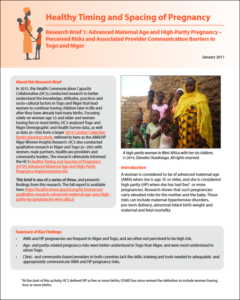Three New Research Briefs on Advanced Maternal Age and High-Parity Pregnancy
“…[F]ive children is good. But if God arranged for us to have more, that would not be a problem.” – male partner of a high-parity woman, urban Niger
In Niger, “God” often does arrange for more. According to the 2012 Niger DHS and Multiple Indicator Survey, a woman will have an average of 7.6 children during her lifetime. This number is higher in rural areas. Sixty percent of women have had a child at age 35 or older. The notion of “limiting” births is widely rejected in Niger, and only 12 percent of women use modern family planning (FP) methods. Often, women and men in Niger see modern FP method use as sinful and in direct conflict to Islam, and often men ultimately prevent women from using FP.
In Togo (2013 DHS), women have closer to five children on average, and, again, this number is higher in rural areas. Nearly half (46 percent) have had a child at age 35 or older. Norms are shifting, though. Particularly in urban areas, couples can discuss limiting how many children they have and women make their own FP decisions. Still only 17 percent of women use modern FP methods and often the fear of being perceived as promiscuous prevents men and women from accepting FP.
In 2014, the Health Communication Capacity Collaborative (HC3) wrote a report explaining the risks associated with pregnancy in women age 35 or older, or who have had five or more births. The report also examined the demographics of women who continued to have children when they were 35 years or older (advanced maternal age, or AMA) and had five or more births (high-parity, or HP).
In 2015, HC3 followed this work by conducting research to learn what factors contributed to and perpetuated such pregnancies in Niger and Togo. This report, available in English and French, showed significant differences between the countries, and, in Togo specifically, further differences around AMA, HP and family planning knowledge, attitudes and practices in rural and urban areas.
HC3 has three new research briefs summarizing the report’s findings around three key themes:
- Perceived AMA and HP pregnancy risks and client-provider communication barriers
- The role of culture and community norms in family planning and AMA and HP pregnancies
- The impact of gender on AMA and HP pregnancy prevalence
HC3 reflected on the findings and acted upon recommendations from this research in the Healthy Timing and Spacing of Pregnancies Implementation Kit (I-Kit), a resource for program managers on how to address AMA and HP pregnancy through existing maternal health and family planning programs. The I-Kit is available in French and English.








Leave a Reply
Want to join the discussion?Feel free to contribute!